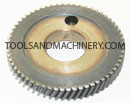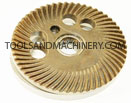 Gears are primarily designed to transmit torque. They are circular and bare teeth, or cogs, as they are referred to technically, to prevent slippage in the transmission process. These toothed machine parts are built to mesh with other toothed machine parts and to, together, transmit rotational energy inside a machine. In your power tools, more specifically, the gears are designed to transfer energy from the armature to the business-end of the power tool, i.e. the chuck or spindle.
Gears are primarily designed to transmit torque. They are circular and bare teeth, or cogs, as they are referred to technically, to prevent slippage in the transmission process. These toothed machine parts are built to mesh with other toothed machine parts and to, together, transmit rotational energy inside a machine. In your power tools, more specifically, the gears are designed to transfer energy from the armature to the business-end of the power tool, i.e. the chuck or spindle.
Gears are also the foremost contributor to many power tools’ ability to move between, well, gears, or speed or torque settings. They can change the speed and direction of mechanical movement and therefore control the amount and kind of power delivered to the working-end of your machine. Essentially, these parts bear a considerable significance in the business-output of your power tools.
HINT: If you have a gear driven tool with more than one torque setting i.e. high and low gears, using the tool in both settings will help you determine more certainly if you have a failing gear and also which gear or set of gears is damaged.
Naturally, (although in a few cases gears are plastic) there is much metal on metal contact in the work of gear- turning. Accordingly, overtime these toothed parts experience the unfortunate side-effect of laying, what some might call, the “smack-down” on each other and, typically, a gear will go bad simply with these rigors of regular wear-and-tear. Depending on how frequently or intensely a power tool is used, it is not uncommon for said machine to require a gear replacement at some point in its life-span.
turning. Accordingly, overtime these toothed parts experience the unfortunate side-effect of laying, what some might call, the “smack-down” on each other and, typically, a gear will go bad simply with these rigors of regular wear-and-tear. Depending on how frequently or intensely a power tool is used, it is not uncommon for said machine to require a gear replacement at some point in its life-span.
Where tools are misused, abused, or otherwise pushed beyond their limits, it is especially common to require a gear (and certainly other components) replacement. In such drastic cases, and perhaps for purely dramatic effect, pieces of a gear (particularly those made of plastic) can jettison entirely out of a tool’s vents. These pieces are not likely to lay the aforementioned gear-style “smack-down” on you, but this kamikaze characteristic is worth noting none-the-less.
Fortunately, for those leery of projectile part pieces and of the civil unrest a failing gear can rouse within a power tool, it is generally simple to detect the symptoms of a beaten gear. For instance, the tool will run roughly or with excessive vibration, it will emit a grinding or crackling noise, the tool might skip or simply punch-out for a moment, the business-end of the tool might stop working when pressure is applied to it, or the tool (despite the motor running) might be entirely unresponsive.
If you are hearing a grinding or, as many technicians describe it, a crackling sound, your gears are very likely grinding against each other or against pieces of each other. When a gear loses part or all of a tooth, it can no longer mesh properly with its toothed companion. This causes an ornery crackling sound which is usually followed by a rough performance from your tool. The thing will vibrate and slightly bounce around resulting in generally poor results and, potentially, further damage to the tool.
A broken tooth or deteriorating gear may also cause the gears and the tool to skip. This manifests, of course, with a skip in the tools performance (this behavior, mind you, is detrimental and not to be confused with a skip in one’s step), or a pause in the actual working of the tool. In other words, while engaged and the motor confidently running, the tool might simply start and stop working. This skip may be accompanied by some chugging or vibration and/or the crackling sound of your gears trying desperately to mesh as they were made to.
Along the same vein, your tool might appear to perform without issue, the working end might proceed as designed, but upon the application of pressure, the tool bumps and stops working. The motor will still run, but the working-end will not work. The malfunction is a result of gears being unable to catch or mesh and turn with that applied working pressure. In this case, although the motor is running, the gears simply aren’t turning.
Similarly, though slightly more dismally, your tool’s motor might run and continue running, but the business-end of the power tool will be totally unresponsive. In this case, the gears can’t engage or mesh or turn in any sense and the tool remains at a literal stand-still.













